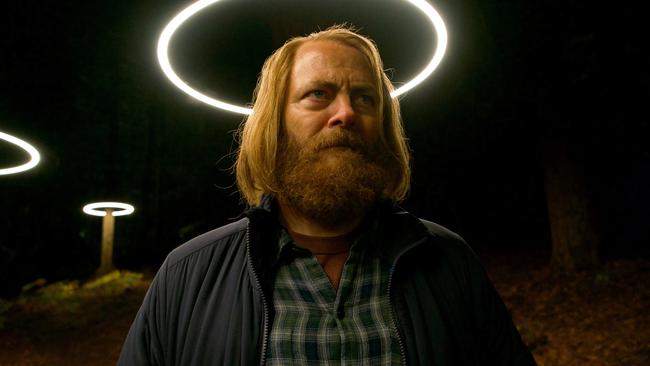Law and military orders
Even a lifetime of ‘internal combat’ couldn’t prepare one teenager for what he would face in the US Army.

The true-crime genre, now such a fixture of our television viewing, goes back to the 16th century when in Germany the early printing press was used to produce broadsheets and pamphlets narrating the crimes and misdemeanours of the condemned. We have always relished the idea of a story being lifted from the raw material of life that will hopefully shape experience and deliver some wisdom.
Given the proliferation of true-crime TV shows, there seems to be a genuine desire to better understand why people act — and react — as they do in extreme circumstances, and why they contribute to, or even create, the terrible situations in which they find themselves.
The latest to examine a recent case in almost forensic detail is the new five-part documentary series Leavenworth, named for the US Disciplinary Barracks at Fort Leavenworth, known as “The Castle” and the only maximum security prison within the US Department of Defence.
It follows the story of Clint Lorance, a US Army infantry officer charged with murder for ordering his soldiers to fire on three unarmed Afghan men approaching them on a motorcycle, killing two and wounding a third. As the men walked towards Afghan troops who were part of the patrol, Lorance was involved in a heated exchange with a soldier in a nearby vehicle, whom he ordered to shoot the three Afghan men.
A staff sergeant repeatedly told the soldier to ignore Lorance’s order, but the soldier eventually opened fire with his M240 machine-gun. The shootings occurred when Lorance was a newly appointed and unpopular platoon leader in the army’s 73rd Cavalry Regiment deployed to the Zhari district in Kandahar province, on July 2, 2012. It was a place where it was almost impossible to distinguish friend from foe.
You may recall Lorance, who served six years of a 19-year prison sentence for war crimes in Afghanistan, was controversially pardoned by Donald Trump last year. He had been championed by Trump advocate Sean Hannity and the US President said after Lorance’s release that he was one of the “great warriors against the deep state” and that soldiers such as Lorance “are mistreated in the military justice system”. Lorance has since become somewhat of a champion of the Right in US politics following his claims that he was nothing more than a pawn whom US generals sacrificed for political expediency.
Directed by Paul Pawlowski, better known for sports documentaries (though Steven Soderbergh is an executive producer), the series initially provides a biographical study of Lorance through interviews with his family and the man himself in prison at Leavenworth. As well as detailing the crimes for which Lorance was incarcerated, it briefly illuminates the history of the many conflicts in Afghanistan, known as “the graveyard of empires” for good reason. Towards the end of the first episode, Pawlowski introduces several members of Lorance’s platoon who testified against him at his court martial.
Pawlowski effectively creates a context for Lorance’s story, putting a common argument that many men who went to war after 9/11 wanted to experience communal masculinity, as their fathers and grandfathers had in Vietnam and World War II, a tradition dating back millennia. Several of Lorance’s men say they “wanted to make a difference” and there was often a family history of service, a form of patriotism built around flag worship.
RELATED: David Stratton reveals his top picks on Netflix | The List: David Stratton’s top 10 movies of 2019
Certainly, Lorance was desperate to enlist — straight after 9/11 at the age of 17 he attempted to enlist and was rejected because of his age. On his 18th birthday he was accepted.
A loner in his highly religious Texas farming community of Celeste (“Small Town, Big Heart”, read road signs), the fact he was gay made him feel even more alienated. Lorance understood that for a young man to feel involved and committed to a small group of men, to have a completely clear identity and a reciprocal duty to those around him was intoxicating. This was especially so for a man who saw little place for himself in the tiny prairie town, though he could never have imagined he would become almost as famous as World War II hero Audie Murphy, who had once lived there.
“I’d gone through a period of my life where I thought I was an abomination,” Lorance, obviously highly intelligent and well-educated, explains in episode one. “My whole life has been internal combat, and so it was natural for me to go into the army. You’re in this small world and you know that a bigger world exists on the outside and you’ve got to see it for yourself. The army was a great place to do that.”
Pawlowski’s interviews reveal a buzz of inclusion among men who have experienced battle together, something Lorance obviously didn’t share with the men he was ordered to command. It was something they resented, especially as Lorance’s well-liked predecessor had recently suffered shrapnel wounds to his abdomen, limbs, eyes and face when a hidden improvised explosive device exploded.
And it was especially difficult for Lorance, known as “a by-the-book guy”, as he had been given orders to “go in strong” with his new command and “police them up”. But the men were bound together as brothers by the terror, monotony, misery, comradeship and lunatic excitement that have been elements of all wars since, say, the siege of Troy. They were young men yielding to the romance of heroic deeds in far-off places under a star-spangled banner. So why did they turn on Lorance?
The first episode is a tasty introduction to an obviously complex story, with the trial, Lorance’s appeals, and the national media controversy that erupts around Lorance to come. And as Pawlowski has foreshadowed, we are in for a compelling discussion of the concept of rules of engagement set against the enduring shame of the My Lai massacre in Vietnam and the problems of ethically grounding a fighting force. On the less abstract side, there is an elucidation of how modern warfare is experienced by those who do the fighting. There is also the apprehension that Lorance’s pardon, given the evidence, might be one of those points where the requirements of justice parted ways with those of politics.
Running right through Pawlowski’s narrative is a mystery — was there a conspiracy that involved Lorance’s comrades so they spontaneously turned on their commanding officer? It’s relatively linear as a documentary: a lot of talking heads, sometimes hard to recall on reappearances, but this story is utterly mesmerising.

I’ve finally caught up with Devs, which comes highly recommended by several colleagues. Devs is from that auteur of the philosophical sci-fi genre, Alex Garland, who wrote and directed the brilliant Ex Machina and the less stellar Annihilation, though like Ex Machina it did garner much critical acclaim.
Somewhat disappointed with theatrical release cinema and the horrors of the so-called “opening weekend” that can make or break a movie, Garland has turned to the small screen for the first time and presents an eight-part series that won’t disappoint fans of his now well-developed narrative sensibility.
Devs is the story of a monolithic Silicon Valley tech company called Amaya, founded by an eccentric genius named Forest, played by the almost monosyllabic Nick Offerman, who looks a little like a middle-aged Jesus. (So brilliant in Parks and Recreation, Offerman has lifted the deadpan mumble to a form of performing art.) On its hi-tech campus Amaya appears to operate in the Google area of cloud-based hosting and statistical algorithms and other data-mining techniques to forecast future events based on historical statistics. So it appears.
Its real work, though, occurs in the mysterious Devs division, so secret Amaya’s employees have no idea what occurs there, except that it is developing secretive applications of Amaya’s quantum-computing technology. The narrative begins when a young Russian, Sergei (Karl Glusman), is invited into the fold by Forest after he delivers a strong presentation on a new project.
He’s delighted but confused about his new role, sharing the news with his girlfriend Lily (Sonoya Mizuno), a fellow Amaya employee working in encryption, who understands the need for secrecy. Forest takes Sergei into Devs, a separate facility which, unlike the sparse Amaya complex, is like an ultra-modernistic Dubai hotel, a building of levitating platforms lined with gold mesh, its interior suspended in a vacuum created by electromagnetic fields.
Sergei is told all he has to do is read code at his laptop and “work it out”. Then he disappears, Lily attempting to solve the mystery of his vanishing in what becomes a kind of techno thriller. You can be sure that while Lily works with clues, making sense of what information she can gather, so will we, Garland’s style parading a delight in obfuscation, what he calls “a sort of suspended state between knowing and forgetting”, and it can be a little irritating.
Leavenworth streaming on Stan.
Devs streaming on Foxtel On Demand.


To join the conversation, please log in. Don't have an account? Register
Join the conversation, you are commenting as Logout